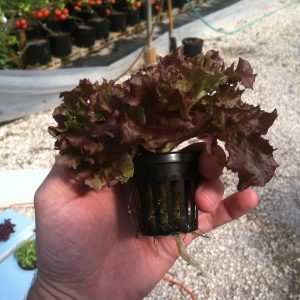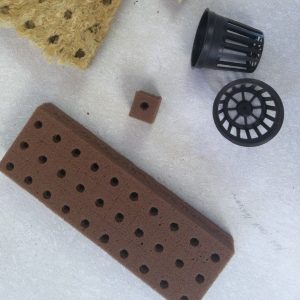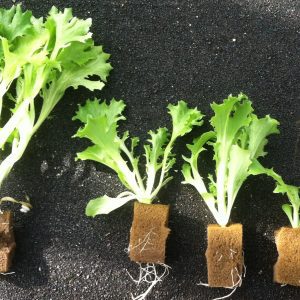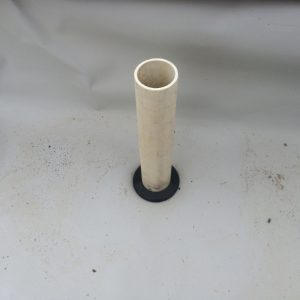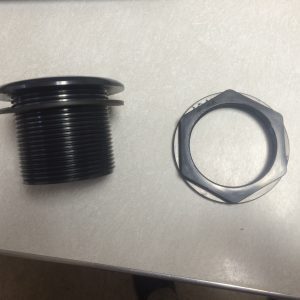Crop Production

Greenhouse lettuce is one of the easier hydroponic crops to grow. It has short crop cycles and low labor demands and can be grown year-round. Lettuce production in hydroponic greenhouse system is factory-like in the way it allows for the production of a high-quality crop on a consistent schedule.
The significantly higher production cost of a greenhouse and its operation, however, make efficiency paramount to success in a greenhouse enterprise. Greenhouse leafy green production differs from other crops in that the product sells by the head, not by weight. Standard lettuce harvest weights are 5 to 6 ounces per head, with an average 30-day crop cycle from transplant to harvest. With other vegetable crops, maximizing yield is a function of yield per area. In lettuce production, yield efficiency revolves around crop cycles per area. Tomato growers, for example, want to maximize yield per area in pounds per square foot (lb/ft2). Leafy green growers focus on moving as many units as possible through the greenhouse each year in the number of heads per square foot (heads/ft2). This way, fixed costs, such as electricity, marketing, management, and depreciation, are spread over more units.
Seedling Production
Production space is expensive, and direct sowing of seeds in a lettuce production system is not an efficient use of space. Seedling production can take place on a fraction of the space used for final planting. Generally, this space should allow for 50 percent of the transplants needed for the grow-out area. A typical 11- by 22-inch nursery flat can easily hold 288 seedlings. In most systems, transplanting seedlings into the system can reduce production time by 2 weeks.
Pelletized seeds are easier to plant by hand or by mechanical seeders. Some smaller production systems use net pots with a well-drained potting media (figure 1); however, most commercial operations now use cubed media made from foam or stone-based mineral fiber insulation such as Rockwool (figure 2). Cubed media comes in perforated sheets that have predrilled sowing holes. The cubes quickly dislodge from the sheets, allowing for faster transplanting. Seeds can be grown in a lower nutrient concentration than that in the grow-out system; however, many small growers use the same concentration for seedlings and grow-out. Ebb and flow systems provide easily automated watering, but hand watering once or twice a day is also an effective way to water seedlings. Using a soft-flow water breaker on a water wand will reduce the impact of water on the seedlings. Seedlings grown in 1-inch cube media are ready to transplant when they have 2 to 3 true leaves and are approximately 2 weeks old (figure 3).
- Figure 1. Lettuce grown in net pot
- Figure 2. Foam and Rockwool cube media and net pots
- Figure 3. Lettuce seedlings at various stages. Ideal size is second from the right
Grow-Out
Once planted, leafy greens are a low-maintenance crop. Production time for most leafy green crops is 30 days. Because most markets require weekly sales, the growing system can be divided into quarters for staggered planting. For example, a 30- by 96-foot greenhouse may have two 12 by 88 beds, with a total crop of 4,752 units. For staggered production, divide the production area into four quadrants, each producing 1,188 units a week. Standard spacing is 8-inch centers with 2.25 plants per square foot. Most heads of lettuce are harvested with about 1 inch of roots at 5.5 ounces.
The Greenhouse Environment
Lettuce can be grown in greenhouses year-round across Alabama; however, success highly depends on the greenhouse environment. Many growers in the northern United States struggle with energy costs associated with heating and supplemental lighting. While these are also causes of concern in Alabama, the primary concern is summer temperatures. In extreme heat, lettuce is prone to bolt, which occurs when the plant begins to go into a flowering stage. Lettuce that bolts becomes bitter and unmarketable.
With a properly designed greenhouse, leafy greens can be successfully grown in the summer months in Alabama. Modern greenhouses have high ceilings to help buffer temperature changes, thereby increasing the volume-to-floor ratio. The gutter or eave of the structure should be 8 feet or higher; high-tech greenhouses have gutter heights of 16 feet or higher. Taller structures are more efficient at buffering temperature changes because there is more air to collect heat per area exposed to solar radiation.
Appropriately designed evaporative cooling systems can be used to lower greenhouse temperatures below outside temperatures; however, this is rarely achieved in Alabama. Many southern states require the use of a 50 percent shade cloth from April to October.
In winter, optimum heating setpoints are 75 degrees F in the day and 65 degrees F at night. While optimum for plant growth, these setpoints may not be optimum for energy costs. Nighttime air temperature can be maintained at 55 degrees or lower. Over time, growers learn the environmental limitations of certain crops and varieties associated with their specific greenhouse and market to maximize growth and energy usage.
Growing Systems
The two primary growing systems for greenhouse lettuce are raft, deep-water culture (DWC), and the nutrient film technique (NFT).
Deep-Water Culture
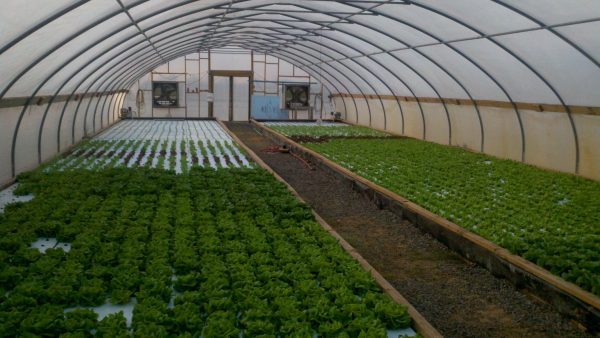
Figure 4. Deep-water culture system in lettuce production
In a DWC system, the crop floats on a nutrient solution (figures 4 and 5). Plants are transplanted into foam rafts with the bottom of the root cube or net pot set at the water surface. Capillary action keeps the potting media moist. Roots grow directly into the nutrient solution and are either pulled back through the existing hole or cut at the surface at harvest. DWC systems are inexpensive to construct but require a lot of water. However, the large volume of water buffers temperature changes in the root zone; handling that volume of nutrient-laden water can be challenging. A DWC system may also require additional maintenance depending on how often it needs cleaning. Yet, the lower implementation cost is advantageous to beginning growers.
Before implementing a DWC system, growers must consider how to design their system, which method of oxygenation and aeration to use, and how to construct rafts.
Design Considerations
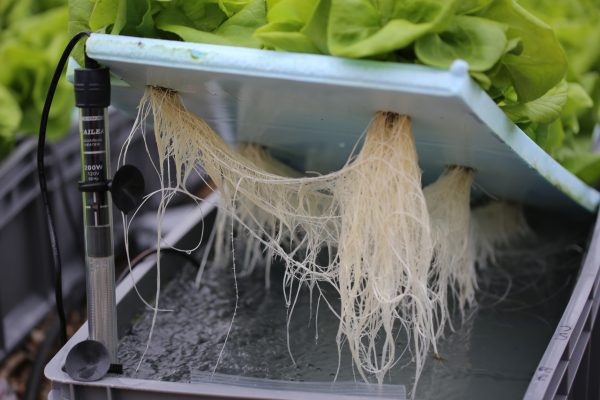
Figure 5. Roots growing in DWC system
The best scenario in designing a DWC system is to start from scratch, with no limitations to the dimensions of the greenhouse. Design considerations include materials and construction, fill and drain time, space optimization, ergonomics, and fertilizer.
The production area of DWC is called a bed, tank, or raceway. It can be made from almost any material, but most are made from dimensional lumber or concrete blocks and are lined with a 20-millimeter or greater high-density polyethylene (HDPE) liner. Manufacturers can mold corners into liners or create corners by making folds during construction.
Raceway dimensions should match the size of the rafts that will sit within them, typically 4- by 8-foot sheets. To reduce waste, design raceways in 4-foot increments for both width and length. Depths of DWC systems range from 6 to 16 inches. Deeper raceways buffer temperature changes better than shallow systems because of the larger volume of water per area. The deeper the raceway, the greater the volume of water needed. Also, as raceway depth increases, so does the amount of fertilizer necessary to maintain adequate concentrations. A raceway with a depth of 8 inches and an area of 12 by 80 feet will require 5,265.92 gallons of nutrient solution. A 12-inch-deep raceway using the same area needs 7,898 gallons of solution. Currently, little data is available for optimum tank depths; however, it is recommended that DWC systems be 8 inches or deeper. The material cost associated with the tank walls may determine tank depth.
As mentioned, HDPE liner can be used for constructing raceways. Tank liners that roll over the top edge of the tank wall and attach to the outside work best and create a surface that is easy to clean. Before making an attachment, first fill the prelined tank with water, and allow the liner to settle for 24 to 48 hours to prevent the liner from tearing. Provide support on the outside of the tank to counterbalance the force of the water on the inside. When filling the raceway for production, leave some space between the solution maximum filling point and the top of the tank.
Another consideration in designing raceways is filling and draining time, as slow draining or filling can hinder the performance of critical tasks. When filling a raceway, consider the flow rate of the water source and the volume of the raceway. It will take a 9-gallon-per-minute (GPM) water hose more than 12 hours to fill a 12-foot by 80-foot by 10-inch bed (6,580 gallons). To reduce drain time, create a slight pitch toward the drainpipes and use oversized or multiple drains with inside diameters of 2 to 3 inches. Using smaller or more shallow raceways rather than larger ones can improve draining and filling time and make it easier and faster to change out the water and clean.
Other design considerations include using removable standpipes to maintain water levels for production (figure 6) and using bulkhead fittings or tank adapters to plumb drains through the liner (figure 7). Place a board under the liner, and plumb the tank adaptor through it to keep the adapter from sagging and subsequently leaking.
- Figure 6. Standpipe in a DWC bed using a bulkhead fitting to plumb through the liner
- Figure 7. Bulkhead fitting
One of the most important aspects to consider in designing a greenhouse lettuce production system is the use of the space. Maximizing the amount of growing space increases yield, but there are certain risks involved with large production raceways versus small ones. For example, a 30- by 96-foot greenhouse can accommodate two 12- by 88-foot raceways. However, if there is a system failure, disease outbreak, or concerns for human pathogen contamination in one tank then half of the crop (2,376 heads of lettuce) has been exposed or killed. Having more, smaller raceways reduces risks in that portions of the crop can be isolated. This type of design requires a more significant initial cost and slightly lowers space efficiency, but the additional costs may save time and money in the long term.
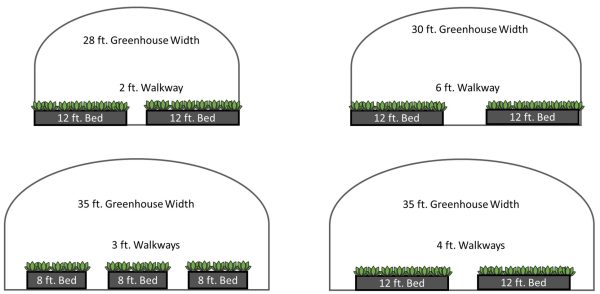
Figure 8. Possible bed configurations for various greenhouse widths
Another design consideration is ergonomics. Having space to perform tasks versus space for more production is often the most cost effective. Narrow walkways and wide beds make harvesting and performing maintenance tasks difficult. Increased accessibility benefits producers and allows for easier pest monitoring and treatment. Also, a comfortable workspace and the ability to complete jobs quickly are invaluable, considering that labor is the primary variable cost. As shown in figure 8, wider greenhouses increase the developmental cost of each structure, but these costs can be spread out over the cost of many crops over several years. Increased bed numbers will increase costs associated with bed construction and plumbing. Fewer and smaller walkways increase labor costs per unit due to poor accessibility. The ideal configuration, however, depends on many factors and will be specific to individual operations.
Dissolved Oxygen and Aeration
Yet another consideration for DWC systems is oxygen supply. Oxygen is often overlooked as an essential nutrient because it is supplied for free in the natural environment. For most DWC systems, however, oxygen must be supplied to the root system for respiration in the form of dissolved oxygen (DO). As with other essential nutrients, it is measured in parts per million (ppm). There is little research on optimum concentrations of DO in DWC systems; however, some recommendations suggest maintaining concentrations of more than 4 ppm.
Water temperature and crop load are essential factors when considering DO and aeration, especially under hot greenhouse conditions. Depleting oxygen can result in plant stress, increased disease susceptibility, root death, or crop loss. The oxygen saturation point is the maximum amount of oxygen a solution can hold and depends on temperature. Water holds less oxygen as water temperature increases. On the other hand, oxygen demand is the amount of oxygen needed for biological and chemical processes. The system’s oxygen demand highly depends on the amount of biomass in a system. Oxygen demand is low for a newly planted crop with a small amount of biomass, but the demand goes up as roots grow.
Aeration increases the DO concentration in the nutrient solution by mixing atmospheric air with the solution. Regenerative blowers push air into the water column through diffusers to create air bubbles. The smaller the bubble, the greater the surface area and the greater the oxygen diffusion rate. Deeper systems provide more hydrostatic pressure, creating smaller bubbles; however, deeper systems require more energy from regenerative blowers or compressors to push air out of diffusers. Smaller bubbles also create less turbulence and splashing when they escape between rafts. Large bubbles create splashing and, subsequently, algae growth on raft surfaces.
Shallow DWC beds are more prone to low oxygen situations for several reasons, including the following:
- Lower hydrostatic pressure, which favors larger bubbles and lower oxygen diffusion efficiency
- A smaller total volume and less oxygen for the system
- Decreased ability to buffer temperature and gain heat faster than deeper systems
Air stones or diffuser tubing supply aeration to the nutrient solution. Air stones have the advantage of not requiring additional weight to keep the diffuser on the tank bottom. They should be cleaned periodically using muriatic acid to ensure efficient diffusion.
Raft Construction
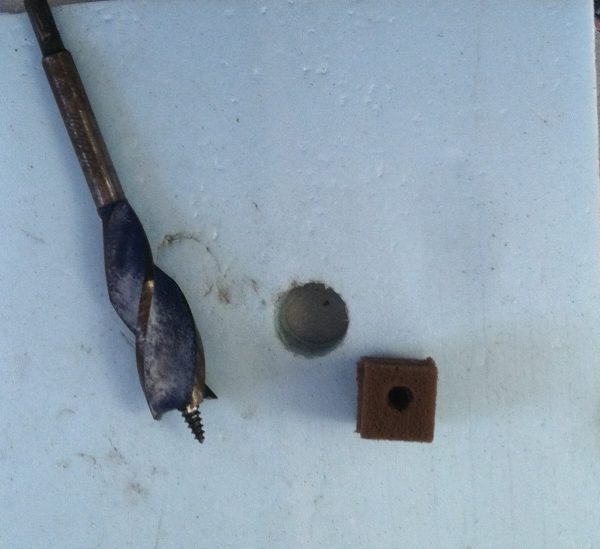
Figure 9. Auger drill bit used to drill holes for cubed media
Large commercial operations typically use high-density expanded polystyrene as raft material due to its durability. Rafts can be anywhere from 3⁄4 to 1.5 inches thick; however, thicker rafts often last longer and are more resistant to wear and tear. Smaller growers may choose to use extruded polystyrene products used in construction. Still, they should know that some extruded products contain fire retardants or other chemicals that may not be food-contact safe.
The standard size for foamboard is 4- by 8-foot sheets. It is best to design float beds in increments of 4 feet. Cutting sheets in half so they are 4 by 4 reduces their weight, making harvesting easier.
If using 1-inch cube media, use a 1⁄28 -inch auger drill bit at a high rpm to drill holes in the raft (figure 9). Multiple rafts can be drilled at one time using drill extensions. Avoid using butterfly or spade bits because they tend to damage rafts, and hole saws need to be cleaned after each hole. To cut larger holes for net pots, use a rotary saw and a template, and cut the holes so that the pot bottom is level with the bottom of the raft so that capillary action will keep the potting media at the correct moisture level. If the net pot sits in the water, there will be no airspace in the potting media, and roots will not be able to respire.
Nutrient Film Technique
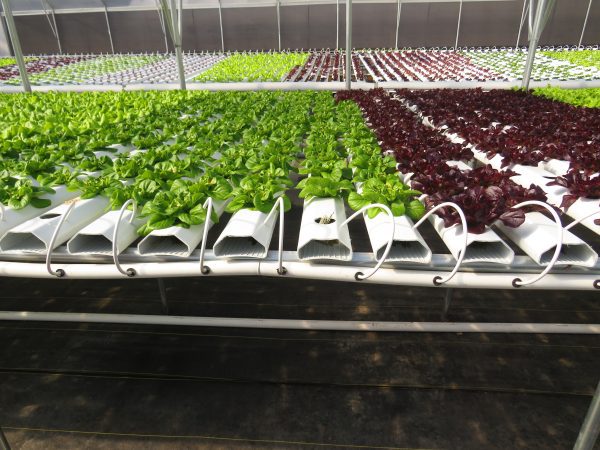
Figure 10. NFT system and components
Another method used for growing greenhouse lettuce is the nutrient film technique (NFT), in which crops are grown in plastic troughs where a thin film of nutrient solution flows over the roots (figure 10). The nutrient solution flows through the channel, empties into a collection tank or sump, and passes through sensors monitoring pH and fertility levels. If adjustments are needed, a dosing system injects fertilizer, base, or acid into the solution before returning it to the NFT troughs. Recirculating the nutrient solution and making on-demand adjustments allows for a smaller working volume of water in the greenhouse. A 1,000-gallon tank can easily accommodate a 30- by 96-foot structure.
NFT troughs are typically 4 inches wide and 2 to 3 inches deep and are made of PVC with a flat bottom. Holes for planting are often spaced on 7.5- to 8-inch centers, with troughs spaced 7.5 to 8 inches on center. Troughs can come in various lengths, but 8 to 12 feet is standard, and a 1 percent slope is often sufficient for most trough lengths. The nutrient solution is supplied to the trough through a 1⁄4-inch or smaller drip tubing. Solution flow rates usually are less than half a gallon per minute.
Fertilizing
Lettuce nitrogen (N) rates range from 130 to 150 ppm with electrical conductivity (EC) readings between 1.15 and 2.1 mhos over the source water. Mixing a hydroponic fertilizer blend can be cheaper per unit of nutrient; however, it is time-consuming for small growers. Most small operations buy a premixed hydroponic fertilizer blend to reduce the risk of miscalculations and time associated with measuring and mixing. Hydroponic fertilizers used in lettuce production usually are in a two-part mixture. Part A contains a smaller proportion of N relevant to the other nutrients (8-15-36) and has no calcium. N is mixed at 30 to 50 ppm using part A. The remaining N supply is from part B, calcium nitrate (15.5- 0-0). Part B supplies 100 to 150 ppm N. A third, optional, component is Epsom salt, which contains less than 10 percent magnesium (Mg) and can significantly increase the bulk of fertilizer; therefore, it is typically omitted from most hydroponic blends to reduce shipping costs. Epsom salt can be purchased in bulk separately and included in the fertilizer solution to supply Mg at a rate of 30 to 50 ppm.
With a dosing system, each component must be injected into the system separately. If mixing to the final concentration, each component must entirely dissolve before the second component is added. Mixing high concentrations of parts A and B will cause precipitation, rendering some nutrients unavailable.
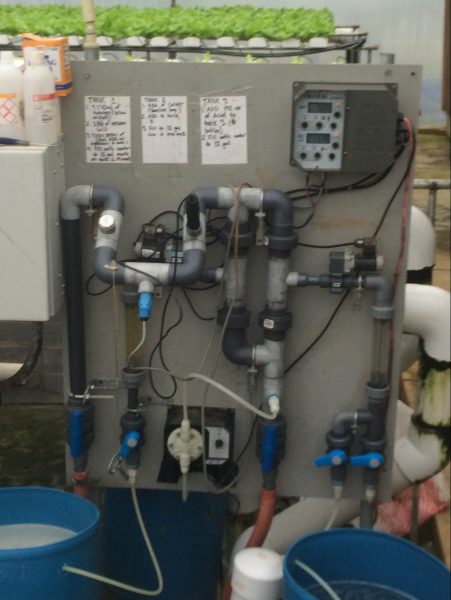
Figure 11. Computerized fertilizer dosing system.
Many commercial NFT systems use controls that monitor EC (figure 11). The amount of nutrients in the system is proportional to the EC of the system. These controls also monitor and adjust pH. Deep- water systems can also use automated dosing control for nutrient management. A best practice is to replace a percentage of the total nutrient solution entirely or partially at a frequent interval throughout the growing system. Because plants do not take up nutrients in the same proportion as applied, frequent replenishing of nutrient solutions will prevent deficiencies or toxicities.
Recommended solution pH ranges from 5.6 to 6.0; however, crops can be grown at higher pH levels if the appropriate type of chelated iron is used. The availability of nutrients is highly influenced by pH. If pH is out of range, toxicities or deficiencies can occur despite the nutrient supply in the fertilizer sump. The alkalinity of the water plays a crucial role in pH maintenance as it provides a buffer against sudden or wide swings in pH. High alkalinity does not necessarily mean a high pH and vice versa; however, water sources with high alkalinity typically have a higher pH. Low alkalinity water can cause wide swings or rapid changes in pH. As plants age due to the increase in carbon dioxide in the nutrient solution released from roots, pH tends to drop rapidly. Carbon dioxide produces carboxylic acid, and alkalinity concentrations will reduce over time. Acids or bases can be used to adjust pH. Common acids include phosphoric, hydrochloric, citric, and sulfuric, the latter being the most widely used due to the lower cost. Bases used to increase alkalinity include potassium bicarbonate, potassium hydroxide, and potassium carbonate.
Routine testing of plant tissue and nutrient solutions is a best practice but may be limited based on economics. Smaller growers often find that completely replenishing the nutrient solution is a more efficient way to correct any problems. Larger growers are more likely to have the resources to analyze tissue and nutrient solutions, and the size of their system may limit their ability to replenish nutrients at an interval that would curtail most problems. Table 1 lists recommended tissue ranges and nutrient solution concentrations for commercial hydroponic lettuce production.
Table 1. Sufficiency Ranges for Lettuce Tissue and Nutrient Concentrations*
* Mills, A. and J. B. Jones. 1996. Plant Analysis Handbook II. Micromacro Publishing. Athens GA.
Jones, J.B. 2005. Hyrdoponics: a practical guide for the soilless grower. Second Ed. CRC Press Washington D.C.
| Macronutrients | Tissue Sufficiency Ranges | Nutrient Solution Concentration Ranges |
|---|---|---|
| Nitrogen | 4.2 to 5.6% | 100 to 200 ppm |
| Phosphorus | 0.6 to 0.7% | 30 to 90 |
| Potassium | 7.8 to 13.7% | 100 to 200 |
| Calcium | 0.8 to 1.2% | 200 to 300 |
| Magnesium | 0.2 to 0.7% | 30 to 80 |
| Sulfur | 0.3 to 0.3% | 70 to 150 |
| Iron | 168 to 223 ppm | 2 to 12 |
| Manganese | 55 to 110 ppm | 0.5 to 2.0 |
| Boron | 32 to 43 ppm | 0.3 |
| Copper | 6 to 16 ppm | 0.01 to 0.1 |
| Zinc | 33 to 196 ppm | 0.05 to 0.5 |
| Molybdenum | 0.29 to 0.58 ppm | 0.5 |
Harvesting
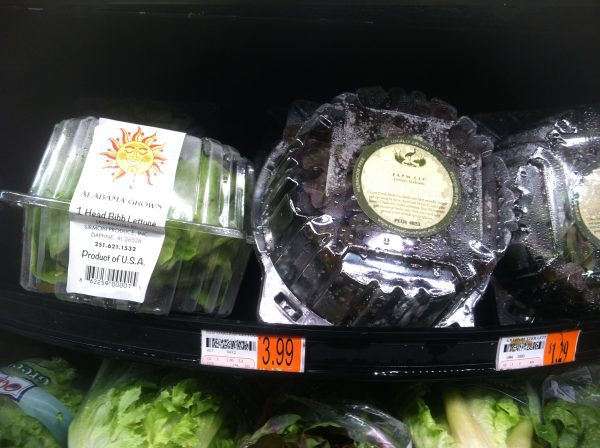
Figure 12. Example of greenhouse lettuce packaged in crispers
Most bibb and leaf lettuce varieties are harvested when leaves begin to touch and crowd neighboring plants. DWC rafts or NFT troughs are often removed from the system for easy harvesting. Plants can be cut at the base or harvested with a portion of the roots attached. Plants with root material still intact are sold as living lettuce in plastic crispers. Heads are about 5.5 ounces when harvested with some roots attached. For food safety reasons, it is vital to prevent splashing and dripping of nutrient solutions on plants as harvested plants are removed. Package plants in plastic crispers (figure 12) or loose in cardboard boxes lined with a plastic liner. Lettuce should be refrigerated immediately after harvest at 32 degrees F.
Marketing
While lettuce is a staple food for most Alabamians, selling the product is often challenging for small growers. Conventional field production in California and Arizona is at an economy of scale that allows for easy marketing. Production cost for greenhouse lettuce is significantly higher than for conventional lettuce, and increased efficiency is often positively correlated with the size of the facility. For a small facility, direct market is often relied upon to bring in a premium price; however, success can depend on the proximity to the market and the market’s willingness to pay a premium. Generally, this requires being within or near an urban area. Direct marketing of greenhouse lettuce for small growers can be difficult for growers in rural areas that are not within a reasonable drive to a market.

 Jeremy Pickens, Assistant Extension Professor; Daniel Wells, Associate Professor, Horticulture; and Caroline Blanchard, Research Associate, Horticulture, all with Auburn University.
Jeremy Pickens, Assistant Extension Professor; Daniel Wells, Associate Professor, Horticulture; and Caroline Blanchard, Research Associate, Horticulture, all with Auburn University.
New July 2022, Greenhouse Lettuce Production, ANR-2903


